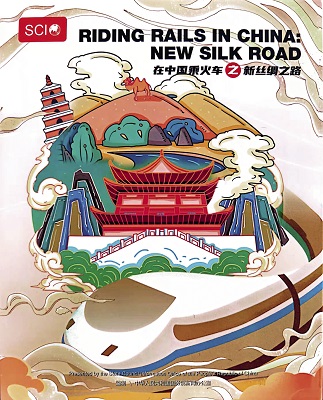
Ancient Silk Road Bursting with History
Riding Rails in China: New Silk Road
Length: 4 episodes
15 minutes per episode
Produced by D3 Production, Inc.
Released by China Intercontinental Press
The four-episode documentary Riding Rails in China: New Silk Road, hosted by a young American couple Jamie Panizales and Gareth Owen, and released by China Intercontinental Press, is more like a cultural adventure tour. They traveled in China along the ancient Silk Road route by high-speed trains, starting from Xi’an, stopping in Lanzhou and Jiuquan, and then moving on to the vast and formidable Gobi Desert, and ending in the cultural city of Dunhuang. Crossing the immense region of desert and looking back into history with the hosts, viewers can almost hear the camel bells echoing in the sand dunes.
Panizales and Owen reside in the San Francisco Bay Area, a region which is a melting pot of cultures in northern California and home to over seven million inhabitants. Panizales hails originally from the Philippines, while Owen’s home country is Wales. Their transnational love and blend of different cultures in the Bay Area have encouraged the young couple to explore more new cultures.
“The journey to the western region of China was actually the most worthwhile travel experience that we will never forget,” said Panizales. Meanwhile Owen was highly impressed by the 160 mph speed of the train. “The train is so comfortable, smooth, and fast. Passengers could get a real sense of the diverse landscapes that we passed through in the vast region of western China,” he said.
In the first episode, the couple began their journey from Xi’an in northwest China’s Shaanxi Province, the starting point of the ancient Silk Road. The city used to be the capital of China for 13 dynasties. Even today, it has a population of 13 million people, which is about four million more than that of New York City.
The couple’s first stop was the Tang West Market, built at the original site of the West Market in Chang’an City during the Tang Dynasty (618-907). In history, the market witnessed the booming trade between China and other countries. Today, it is still a modern international trade center, gathering goods from the West as far as Rome, to the East as far as Seoul.
They then stopped at the Tang West Market Museum, which stores more than 20,000 pieces of cultural relics from the Shang Dynasty (1600-1046 B.C.) to the Qing Dynasty (1644-1911). From the splendid and historical exhibits, the audience can get a glimpse of the great Chinese civilization and the significance of reviving the ancient Silk Road, which links the East and the West.
In the second episode, the young couple rode on a high-speed train from North Xi’an Railway Station towards Lanzhou, capital city of northwest China’s Gansu Province. The city has a population of over four million people, slightly more than that of Los Angeles, but its size is ten times bigger. It is also a major link on the northern Silk Road.
In Lanzhou, they stopped by the Yellow River and rode on an old-fashioned sheepskin raft. The raft was once an important transportation tool for locals living along the banks of the Yellow River.
“It is a kind of genius the way they used the sheepskin as buoyancy devices to get from one side of the river to the other,” said Owen.
The third episode records the couple’s visit to the cargo redistribution center in Lanzhou, where several freight trains were being loaded with merchandise from different provinces of China. From one perspective, it reflects that the revived Silk Road, as part of the Belt and Road Initiative proposed by Chinese President Xi Jinping in 2013, is playing a pivotal role in building closer economic ties between Europe and Asia.
After visiting the redistribution center, they continued their high-speed train tour from West Lanzhou Railway Station, heading northward to Jiuquan, an ancient city in northwest Gansu. The train passed smoothly through a barren dessert-like landscape, and then through several tunnels under the mountains. In Jiuquan, they boarded a train to their final destination – Dunhuang.
The last episode was shot in the Mogao Caves, or the Thousand Buddha Grottoes, which are famous for their splendid murals and painted sculptures, spanning some 1,000 years from the 4th to the 14th century.
The most impressive and imposing statue for the couple was the Northern Giant Buddha, a 112-feet tall colossal Buddha, made of clay stucco over a sandstone frame. It is the second largest Buddha statue in the world. Inside the cave, they could see the bottom of the Buddha’s robe, which was meticulously painted. Looking upward, they could see the Buddha’s round face, the three lines on his neck and the wave-like hair, which are all characteristics of early Tang sculptures.
“The Mogao Caves are of unmatched historical value,” said Owen, who indicated that these works depict various aspects of medieval politics, economics, culture, art, religion, ethnic relations, and even daily dress in western China.
The distances between cities on the ancient Silk Road have been dramatically shortened by high-speed trains. Meanwhile, the spirit of the Silk Road that embodies peace and cooperation, openness and inclusiveness, mutual learning and mutual benefit, has never faded and in fact has become a great heritage of human civilization.